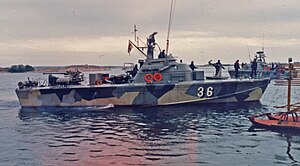
The Type II U-boat was designed by Nazi Germany as a coastal U-boat, modeled after the CV-707 submarine, which was designed by the Dutch dummy company NV Ingenieurskantoor voor Scheepsbouw Den Haag (I.v.S) and built in 1933 by the Finnish Crichton-Vulcan shipyard in Turku, Finland. It was too small to undertake sustained operations far away from the home support facilities. Its primary role was found to be in the training schools, preparing new German naval officers for command. It appeared in four sub-types.

A gunboat is a naval watercraft designed for the express purpose of carrying one or more guns to bombard coastal targets, as opposed to those military craft designed for naval warfare, or for ferrying troops or supplies.

The Finnish Navy is one of the branches of the Finnish Defence Forces. The navy employs 2,300 people and about 4,300 conscripts are trained each year. Finnish Navy vessels are given the ship prefix "FNS", short for "Finnish Navy ship", but this is not used in Finnish language contexts. The Finnish Navy also includes coastal forces and coastal artillery.

Ilmarinen was a Finnish Navy Panssarilaiva. The unit was constructed at the Crichton-Vulcan shipyard in Turku, Finland, and named after the mythological hero Ilmarinen from the Finnish national epic, the Kalevala. Ilmarinen was the flagship of the Navy from 1 May 1933 until her sinking on 13 September 1941.

A motor torpedo boat is a fast torpedo boat, especially of the mid 20th century. The motor in the designation originally referred to their use of petrol engines, typically marinised aircraft engines or their derivatives, which distinguished them from other naval craft of the era, including other torpedo boats, that used steam turbines or reciprocating steam engines. Later, diesel-powered torpedo boats appeared, in turn or retroactively referred to as "motor torpedo boats" for their internal combustion engines, as distinct from steam powered reciprocating or turbine propulsion.

The motor gun boat (MGB) was a small, high-speed British military vessel of the Second World War, which was armed with a mix of guns, in contrast to the physically similar motor torpedo boat (MTB), whose main offensive weapon were torpedoes. The small size of the MGBs, and their high speed, made them difficult targets for German E-boats, though, like their opponents, they were limited by heavy weather, because they did not provide a stable-enough platform to aim the guns. The large number of guns meant the crew was relatively large, numbering as high as thirty men on the largest boats.

A fast attack craft (FAC) is a small, fast, agile, offensive, often cheap warship armed with anti-ship missiles, gun or torpedoes. FACs are usually operated in close proximity to land as they lack both the seakeeping and all-round defensive capabilities to survive in blue water. The size of the vessel also limits the fuel, stores and water supplies. In size they are usually between 50–800 tonnes and can reach speeds of 25–50 knots (46–93 km/h).

Marine propulsion is the mechanism or system used to generate thrust to move a ship or boat across water. While paddles and sails are still used on some smaller boats, most modern ships are propelled by mechanical systems consisting of an electric motor or engine turning a propeller, or less frequently, in pump-jets, an impeller. Marine engineering is the discipline concerned with the engineering design process of marine propulsion systems.
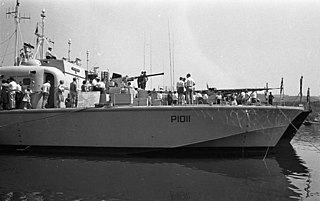
The Brave-class fast patrol boats were a class of two gas turbine motor torpedo boats (MTBs) that were the last of their type for the Royal Navy (RN) Coastal Forces division. They formed the basis for a series of simpler boats which were widely built for export.
The Russian submarine AG-12 was an AG-class submarine, designed by the American Holland Torpedo Boat Company/Electric Boat Company, built for the Imperial Russian Navy during World War I. The submarine was fabricated in Canada, shipped to Russia and reassembled for service with the Baltic Fleet. She was scuttled by the Russians at Hanko in April 1918.
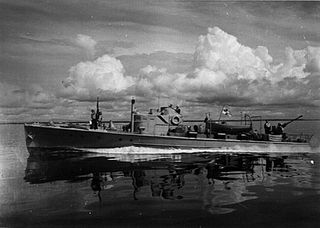
VMV-class patrol boat was a series of Finnish patrol boats, which served with the Finnish Coast Guard and the Finnish Navy during World War II.

The Taisto class motor torpedo boats or T class was a Finnish-designed class of motor torpedo boats, which saw service with the Finnish Navy during World War II.

Steam gun boats (SGBs) were small Royal Navy vessels built from 1940 to 1942 for Coastal Forces during the Second World War. The class consisted of nine steam-powered torpedo boats.

Riilahti was a Ruotsinsalmi class minelayer of the Finnish Navy. Riilahti was commissioned in 1940 and sunk in 1943. The vessel was named after the battle of Riilahti, which was fought between Sweden and Russia in 1714.

Wilhelm Carpelan is a former Von Fersen-class transport boat. Built in 1915 for the Imperial Russian Navy, she was used as a transport boat and later a minesweeper by the Finnish Navy until 1977. After decommissioning, she was sold to private ownership and used as a pleasure boat. In 2013, Wilhelm Carpelan was donated to the collections of Forum Marinum, the maritime museum in Turku, Finland.

Forum Marinum is maritime museum located in Turku, Finland.

W:m Crichton & C:o Ab is a former engineering and shipbuilding company that operated in Turku, Grand Duchy of Finland in 1842–1913. The company also had another shipyard in Okhta, Saint Petersburg.
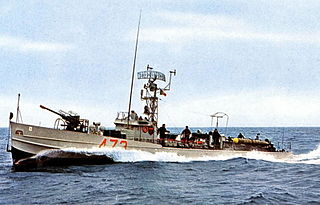
The Motosilurante CRDA 60 t was a type of motor torpedo boat built for the Regia Marina during World War II. It was designed on the pattern of German E-boats—some early examples of which were captured by the Italians from Yugoslav Navy—to complement the faster but less seaworthy MAS boats. It was two Motosiluranti CRDA that scored the biggest success by fast torpedo craft in the Second World War, the sinking of British light cruiser HMS Manchester. After the conflict surviving boats remained in service with the Marina Militare—the last ones being ultimately dismissed after almost 40 years of service, in the late 1970s.

Sisu was a Finnish state-owned icebreaker. Built in 1939 at Wärtsilä Hietalahti Shipyard in Helsinki, she was one of the world's first diesel-electric icebreakers. In addition to icebreaking duties, she served as a submarine tender for the Finnish Navy during the summer months until the end of the Continuation War.
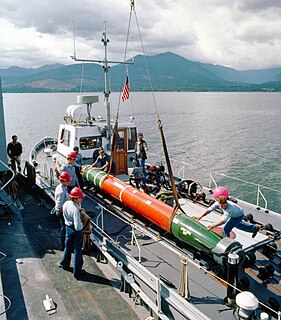
United States Navy submarines, surface ships, and aircraft launch torpedoes, missiles, and autonomous undersea vehicles as part of training exercises. Typically, these training munitions have no warhead and are recovered from the sea and reused. Similarly, new naval weapons under development are launched at sea in performance trials. These experimental units also need to be recovered, in their case to obtain evaluation data. At various points in history, newly manufactured torpedoes were fired as a quality control measure and these, too, had to be recovered before issuing them to the fleet. The U.S. Navy has used a variety of boats to accomplish the retrieval of these test and training munitions. As their missions evolved over the last century they have been variously known as torpedo retrievers, torpedo weapon retrievers, torpedo recovery boats, range support craft, and multi-purpose craft.
